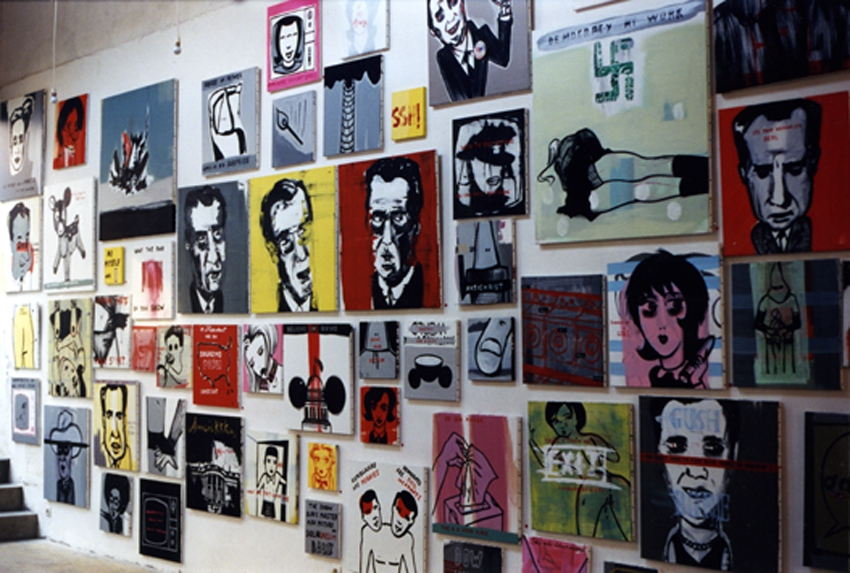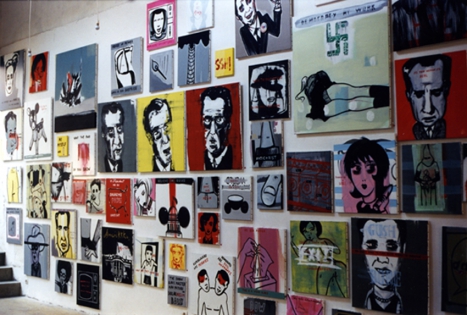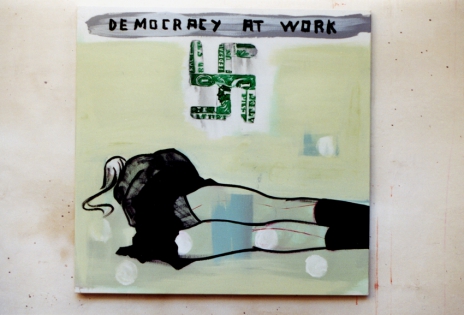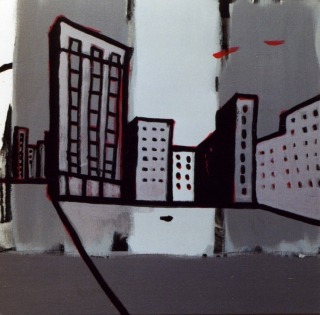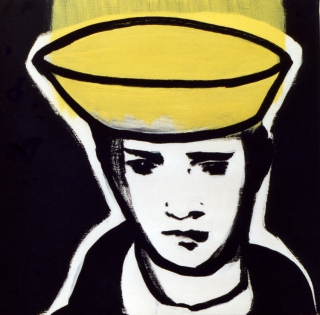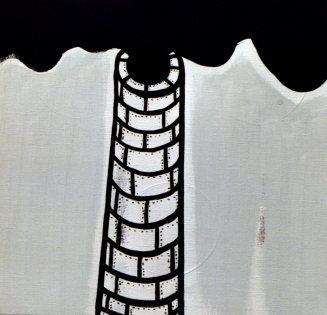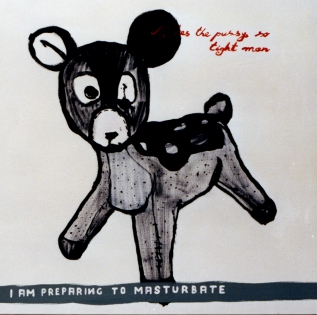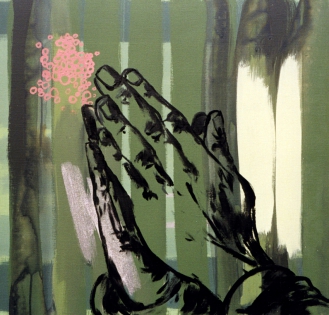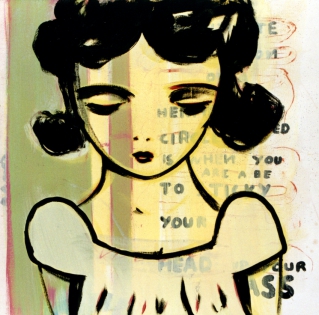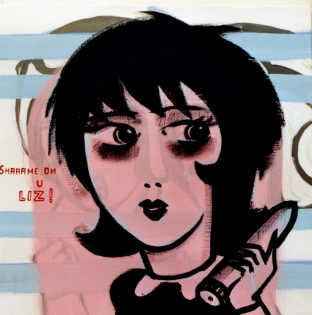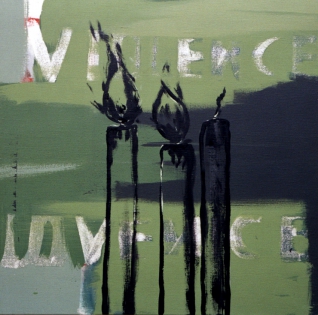NIXON
Bruno Bressolin’s works give the impression of being haphazardly painted and drawn onto various sized canvases. Images and slogans combine making political and sexual references. Scandalous topics, such as Bill Clinton and Monica Lewinsky, the Ku Klux Klan and Nazisl (indicated by the omnipresent swastika) ar prominent among the texts and images, as are most issues dealing with America and sexuality. America seems omnipresent also in the fact that all of the texts are written in English, a rather crude American English. The images are equally crude both in content and in technique. One painting shows a nude female on her hands and knees with splayed legs, her rear raised with the words « I want it dirty » written across the bottom of the canvas. Another painting shows two beds, one messy, the other neat. The caption says, « How Prozac Slew Freud ». One assumes the messy bed is Freud, the neat one Prozac. It’s fun and stimulating on several levels, wich makes this work one of the more successful one of the show.
Three canvases, actually rather nicely painted technically, show cars wrecked in a deserted and devastated city landscape. It is unclear whether there has been an earthquake, a bomb or some other catastophe, buy the sense of doom and desolation is effective. Throughout the works, lines and images are overtly/covertly sexual : cracks signifying asses and cunts ; guns, bolsters and lipsticks representing phalluses/pricks. All this obsessive sexuality makes you wonder why these images, even while crudely displaying themselves as lascivious, inhibit sensual feelings in the viewer. Perhaps it’s because desire is lessened through exposure to ridicule ? That it is the artist’s intention to represent desire as well as socio-political issues as ridiculous, hypocritical and pompous seems apparent but is there anything new being said there ? I there anything that gives one a different perspective in the issues of sexuality an political and social hypocrisy ? Obviously, politics, sex and war can be symbols of oppression and of deceit. Yet, in spite of the ho-hum-I’ve-been-there-seen-this feeling of Bressolin’s work, the show succeeds in it overall theme of reminding us of our own fallibility. Not because it is new precisely because it is so old, so common, so predictable, ans so eternally apropos that it is as inescapable as dirty jokes.
Carinne Van-Houten - NIXON - Art-Papers Magazine USA - 2001
Interrogé sur les sources de cette série de peintures, Bruno Bressolin situe le début de sa réflexion aux années Nixon. Exemple type selon lui du président politiquement incorrect, ce personnage pourrait être à l’origine d’une déviance de tout genre faisant partie de la vie quotidienne. Dans cette Amérique libérale où tout est permis ou presque, on peut être puritain et se complaire dans les images de sexe, catholique, raciste et favorable aux armes à feu tout en proposant à ses enfants Disneyland comme principal univers spirituel... Bref, au-delà de ces “icônes” contemporaines, des ces Monica et cetera, peut-être peut-on se demander pourquoi le reste du monde s’empresse de singer ce modèle tant décrié. Un paradoxe de la nature humaine qui est cher à Bruno Bressolin : n’y aurait-il pas, dans la contemplation de ces images, un zeste de plaisir sadomasochiste, thème largement présent dans le reste de sa peinture.
Carinne Van-Houten - NIXON - Art-Papers Magazine USA - 2001
Three canvases, actually rather nicely painted technically, show cars wrecked in a deserted and devastated city landscape. It is unclear whether there has been an earthquake, a bomb or some other catastophe, buy the sense of doom and desolation is effective. Throughout the works, lines and images are overtly/covertly sexual : cracks signifying asses and cunts ; guns, bolsters and lipsticks representing phalluses/pricks. All this obsessive sexuality makes you wonder why these images, even while crudely displaying themselves as lascivious, inhibit sensual feelings in the viewer. Perhaps it’s because desire is lessened through exposure to ridicule ? That it is the artist’s intention to represent desire as well as socio-political issues as ridiculous, hypocritical and pompous seems apparent but is there anything new being said there ? I there anything that gives one a different perspective in the issues of sexuality an political and social hypocrisy ? Obviously, politics, sex and war can be symbols of oppression and of deceit. Yet, in spite of the ho-hum-I’ve-been-there-seen-this feeling of Bressolin’s work, the show succeeds in it overall theme of reminding us of our own fallibility. Not because it is new precisely because it is so old, so common, so predictable, ans so eternally apropos that it is as inescapable as dirty jokes.
Carinne Van-Houten - NIXON - Art-Papers Magazine USA - 2001
Interrogé sur les sources de cette série de peintures, Bruno Bressolin situe le début de sa réflexion aux années Nixon. Exemple type selon lui du président politiquement incorrect, ce personnage pourrait être à l’origine d’une déviance de tout genre faisant partie de la vie quotidienne. Dans cette Amérique libérale où tout est permis ou presque, on peut être puritain et se complaire dans les images de sexe, catholique, raciste et favorable aux armes à feu tout en proposant à ses enfants Disneyland comme principal univers spirituel... Bref, au-delà de ces “icônes” contemporaines, des ces Monica et cetera, peut-être peut-on se demander pourquoi le reste du monde s’empresse de singer ce modèle tant décrié. Un paradoxe de la nature humaine qui est cher à Bruno Bressolin : n’y aurait-il pas, dans la contemplation de ces images, un zeste de plaisir sadomasochiste, thème largement présent dans le reste de sa peinture.
Carinne Van-Houten - NIXON - Art-Papers Magazine USA - 2001
